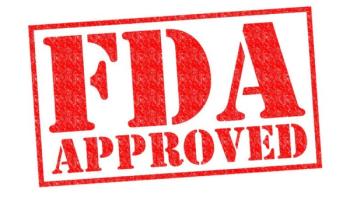The U.S. Food and Drug Administration (FDA) has granted fast track designation to DB-1310, a HER3-targeting antibody-drug conjugate (ADC), for the treatment of adult patients with advanced, unresectable or metastatic nonsquamous non-small cell lung cancer, according to a news release from DualityBio.
The fast track designation includes patients with advanced, unresectable or metastatic nonsquamous non-small cell lung cancer with an EGFR exon 19 deletion or L858R mutation with disease progression on or after treatment with a third-generation EGFR tyrosine kinase inhibitor and platinum-based chemotherapy.
Glossary
Disease control rate: percentage of patients whose cancer shrinks or stays stable after treatment.
Duration of response: how long cancer remains controlled after it first responds to treatment.
Overall response rate: percentage of patients whose cancer shrinks or disappears after treatment.
Progression-free survival: time patients live without cancer growing or spreading.
Interstitial lung disease or pneumonitis: inflammation or scarring in the lungs that can cause breathing problems.
Neutrophil count: number of a type of white blood cell important for fighting infections.
Lymphocyte count: number of a type of white blood cell involved in immune response.
Albumin levels: amount of a protein in the blood that helps keep fluid in blood vessels.
AST (aspartate aminotransferase): an enzyme measured in blood to assess liver health.
“DB-1310 demonstrated encouraging clinical efficacy and manageable safety in patients with [this disease] and multiple solid tumors,” Dr. Hua Mu, global chief medical officer of DualityBio, said in the news release. “It is noteworthy that preclinical investigations of DB-1310 in combination with EGFR tyrosine kinase inhibitors and other anticancer agents have also demonstrated robust synergistic tumor suppression activity. We will spare no effort to accelerate the clinical development of DB-1310 and look forward to its potential, as a next-generation HER3 antibody-drug conjugate, to become a novel therapeutic option for a broad population of [patients with] cancer.”
In June 2025, Dr. Aaron E. Lisberg of the University of California, Los Angeles, shared early clinical trial results for DB-1310 during an oral session at the American Society of Clinical Oncology (ASCO) Annual Meeting. The phase 1/2a study showed antitumor activity and a manageable safety profile in patients with advanced solid tumors that had not responded to standard treatments.
Among 62 safety-evaluable patients with EGFR-mutated non-small cell lung cancer, any-grade and grade 3 (severe) or higher side effects occurred in 95.2% and 46.8% of patients. Treatment-related side effects were reported in 91.9%, with 35.5% experiencing grade 3 or higher; these led to dose interruptions in 21%, dose reductions in 9.7%, and treatment discontinuation in 3.2% of patients.
Among 46 efficacy-evaluable patients, the unconfirmed and confirmed overall response rates were 28.3% and 43.5%, the disease control rate was 91.3%, and the median duration of response, progression-free survival and overall survival were 5.8, 7 and 18.9 months, respectively.
DB-1310 is a new type of ADC designed to target HER3, a protein found on some cancer cells. It was developed using the DITAC platform, a specialized technology from DualityBio.
Common Side Effects in Overall Study Population
In the overall trial population, regardless of cancer type, the most frequently reported treatment-related side effects in at least 15% of patients included anemia (37.2% mild/moderate, 4.7% severe), decreased neutrophil count (21% mild/moderate, 20.9% severe), nausea (37.8% mild/moderate, 0.6% severe), decreased platelet count (26.8% mild/moderate, 11.6% severe), decreased white blood cell count (26.8% mild/moderate, 8.7% severe), decreased appetite (25.6% mild/moderate, 0.6% severe), vomiting (22.7% mild/moderate, no severe cases), hair loss (20.3%, all mild/moderate), low albumin levels (19.8%, all mild/moderate), low sodium levels (17.4%, all mild/moderate), elevated AST (17.4%, all mild/moderate), and decreased lymphocyte count (10.5% mild/moderate, 6.4% severe).
Unconfirmed cases of interstitial lung disease or pneumonitis occurred in 5.2% of patients (9 individuals), including 8 mild cases and 1 moderate case reported at the 5 milligrams per kilogram dose level.
Study Design of DB-1210-O-1001
The DB-1210-O-1001 trial enrolled adults with advanced or metastatic solid tumors that had progressed despite standard treatments. Eligible patients needed at least one measurable tumor, good daily functioning and healthy organ function. Patients with treated and stable brain metastases could also participate, but those previously treated with HER3-targeted therapies or similar antibody-drug conjugates were excluded.
In the first phase, DB-1310 was given every three weeks in increasing doses to determine the safest and most effective amount. Patients with EGFR-mutated non-small cell lung cancer were prioritized at certain dose levels.
The main goals were to identify serious side effects, find the highest safe dose, and evaluate overall safety. The study also looked at how well the drug worked by measuring tumor shrinkage, disease control, duration of response, progression-free survival and overall survival.
References
- “DualityBio’s next-generation HER3 ADC DB-1310 granted FDA fast track designation.” DualityBio news release, July 22, 2025.
- “DB-1310, a HER3-targeted ADC, in pts with advanced solid tumors: Preliminary results from the phase 1/2a trial,” by Dr. Lisberg A, et al., J Clin Oncol.
For more news on cancer updates, research and education, don’t forget to subscribe to CURE®’s newsletters here.






